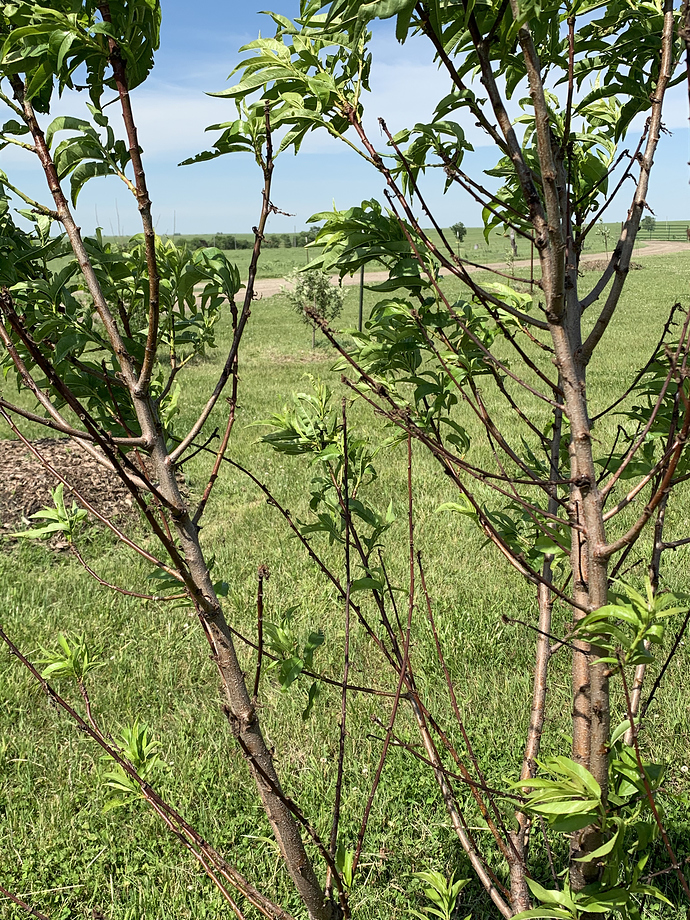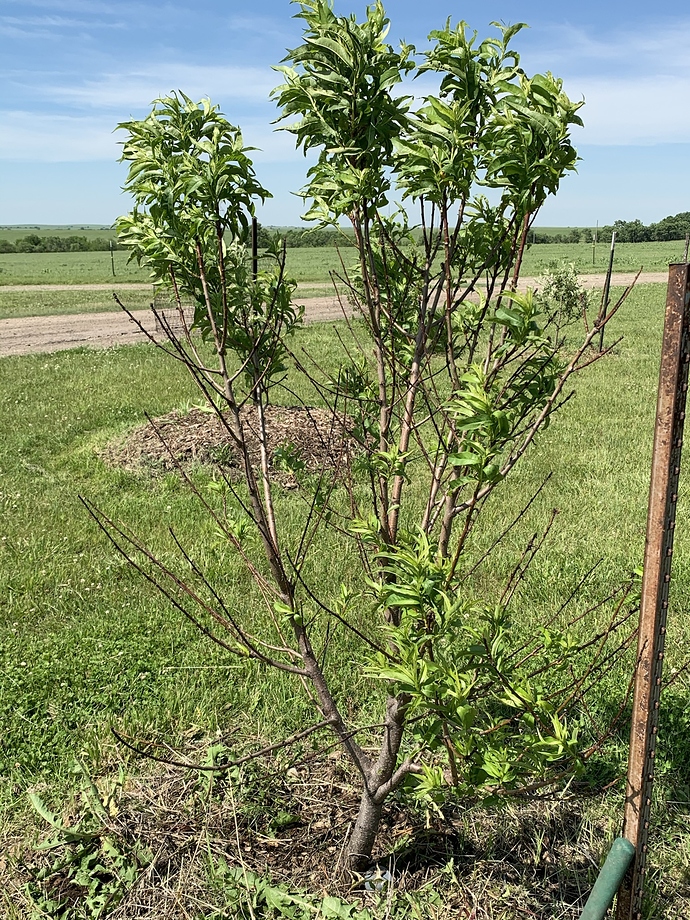I wondered about that too; I’ve never run across it before and don’t know. Maybe someone else will tell us, maybe espalier people?
I have been learning about tree training and have a good video of explanation on this topic. This type of training seems like it would work well for trees that are one-sided, or if you want to decrease the number of years that it might take for a whip to come up with the form that you want. I would be interested in seeing what others think about this idea, or hearing about your success stories (or lack there of)
another advanced technique: if you have a big whippy leader that you want to branch, put a clear bag over it some time before bud break in the spring and close up the bag. this can make a kind of greenhouse to raise the temperature of the leader vs. the rest of the tree and you can get side shoots because the leader will break dormancy before the rest of the tree. then follow up with promalin. see this guide:
One thing I’ll mention with some of the pruning links posted, is that there is no mention of the deleterious effects of pruning peaches in the winter.
We’ve pruned peaches at any time of the year, including winter because sometimes that’s when the labor/time is available. That said, it’s generally the least favorable time to prune winter tender trees like peaches.
With dormant pruning, you can expect more flower bud kill during winter some years, with peaches.
Pruning just before bloom can reduce hardiness of blooms as well as causing a slightly earlier bloom (both negatives for peaches).
Pruning just before winter can also reduce hardiness for peaches. Ideally prune peaches at the end of summer, or during the summer, or just after petal fall.
In an ideal world, we like to prune out unproductive shoots just after petal fall (unproductive meaning shoots with no fruit set). Then come back in early July to remove all the new water spouts and keep the trees opened up for next years flower bud development. Then come back in Sept for the last follow up pruning for the year. This ideal pruning schedule almost never happens because of time/labor constraints.
Here is a resource regarding timing of peach tree pruning, if interested.
Here is a note about UFO peaches. Interesting they say UFO is more susc. to ethylene which is produced by dormant pruning, which causes flower bud absorption. I know ethephon (which is basically liquid ethylene) has been tested on dormant peach trees to delay bloom. It also kills some flower buds.
http://www.ffsp.net/varieties/peach/ufo/
Lastly, it’s common to see the myth that dormant pruning stimulates growth vs. summer pruning in pruning guides. That myth has been debunked by newer research.
@Olpea, Based on your past posts on the subject of pruning peaches, and our similar latitudes, I have followed your practice of waiting until after petal fall to prune my peaches. Spring 2020 was really hard on my peaches, as it was for you too. I am very glad I hadn’t pruned in late winter.
The late freeze we had on April 25 caught my peaches in almost all stages from bud burst, full flower, to petal fall. Needless to say we had zero fruit set. I ended up with some dead branches that I think were freeze-killed, those I pruned out in the summer. I had so much dead space on branches that I decided not to prune in the spring, hoping that the branches would put out new growth.
There weren’t any buds along the bare stretches of branches that leafed out, so growth was only at the tips.
When I prune this spring 2021, after petal fall, if I cut back into those bare areas, this should stimulate new growth? Last year I was afraid of removing those growing tips because they contained the only photosynthetic material the tree had. Maybe I could have safely pruned later in the summer, but I was unsure so I just let them grow however they could manage. The younger trees were hit harder than the more mature trees.
Here is an example of a 2018 tree, Sweet Sue. My more mature trees looked similar, but the pictures I took don’t show the “dead” areas very well.
This particular tree is shaped very poorly. It had some die-back the year it was planted, and I didn’t want to prune off new growth. I do need to do some serious shaping of it this spring or summer.
That bottom pic does look pretty rough. You’re right, lots of die back. You did right, imo, not to prune those trees back.
Next spring, once the threat of spring cold temperatures has passed, I would try to prune a lot of that top foliage off, and allow the bottom foliage more opportunity to grow. Then maybe you can get the tree back to growing like a good vase tree.
Boy do I appreciate your input, Olpea. I am glad I waited to prune. Thank you for setting my mind at ease. I will follow your advice.
I have been contemplating taking off both of the lower limbs on the left and right of the main trunk. I don’t like the crotch angles and they come off very low on the trunk. I think I can chose 4 or so good laterals on the main trunk to train into vase shape. I should take some better pictures, it is difficult to see on these.
@Rosdonald- my sympathies! Such a disappointment!
It’s hard to tell from pictures, but the crotch angles don’t look that bad to me. You’ll want to look for bark inclusions at the crotch to see if you will have a problem. That’s mainly what I look for. Also if the diameter of the future scaffold is much more than about 1/3 of the trunk diameter, then the scaffold won’t form a collar, and can become a potentially weak scaffold.
Other than that, you don’t want two scaffold originating at the same height on the trunk, if you can help it.
The overall height where the scaffold starts on a trunk is entirely up to the grower and the equipment needed to get under the tree. If you plan to mow under the trees with a push mower, then the scaffolds can be quite low, without any trouble. I use a sickle mower to mow under my trees at the orchard, so I can start the scaffolds fairly low.
When you prune the tree this spring, don’t prune all the foliage off at the top. Just most of it. I’m afraid there is so little foliage down low, you could kill the tree if you prune all the foliage off the top. Once the summer gets going and you coax some more foliage down low, then you should be able to remove the rest of the top foliage.
Thank you for your advice! I was worried about pruning out too much and killing the tree, so following your guidance, the tree will have a better chance.
I don’t think I have read that scaffolds greater than 1/3 diameter of the trunk are not able to form collars. Thanks for that information too. In trees with a central leader, I have understood its best to remove any laterals that are greater than 1/3 the trunk diameter at the attachment point so it doesn’t compete with the central leader.
I think it is weird, or interesting anyway, how so many of my trees (not just peaches) form a “Y” on the trunk. So it has two competing scaffolds coming off the main trunk at the same place. I remove one as soon as I catch it, unless there is not a lot of growth in general. Then I am inclined to leave it to maximize photosynthetic capabilities. I usually regret doing this because then then tree puts a lot of growth into a scaffold that is going to be removed later.
The trees I have started from seed for grafting purposes also tend to branch very low, less than 6” from the soil line. How do you deal with this? Do you find this common in your seedlings you grow out for grafting?
We do most of our grafting on peach seedlings which have one season’s growth, so they are mostly small feathered trees about 1/4 to 1/2" in diameter. We bud them in the fall, then move them and behead above the grafted bud, then they are generally off to the races. The little bud grows that next spring. It will start to put out some feathers again. I just cut or tear off the feathers which are too low, or placed where I don’t want them.
Then I’ll finally select 3 (generally) which are evenly spaced around the tree, not more than 1/2 the diameter of the scaffold (although I prefer 1/3, the smaller the better), spaced at least a couple inches vertically from one another, with decent crotch angles. Then I just let those grow.
With apples you want small diameter shoots when selecting scaffolds (relative to the trunk) because larger scaffolds suck up too much energy and create an overvigorous scaffold. With peaches, the biggest issue is that large diameter scaffolds (again relative to trunk size) won’t form a collar and are subject to breakage/splitting at the trunk. You can see very early on if the scaffold will form a collar or not. I’ve also found that some of this is variety driven. Some varieties of peaches will form collars even on larger scaffolds, whereas others have more difficulty forming collars. Encore for example, doesn’t like to form collars on scaffolds much larger than 1/3 the diameter of the trunk.
I need to go out and look at my scaffolds on the various peach trees. I haven’t paid attention to collar formation, so I don’t know if my trees are developing as they should be. I also need to check for bark inclusions at the crotch.
Thanks again, @Olpea, there is a wealth of information here. I am still learning! Always learning! Just when I think I might have a clue what I am doing…
So, during the growing season, is it ok to prune off newly forming branches (from the trunk) when they are only a couple inches long? If I already have my scaffold limbs picked out, will pruning these new branches force the tree into growing the scaffold limbs, or will there be an adverse effect?
You can prune them off. The tree will put resources into growing existing scaffolds if you prune out smaller competing branches.
Keiki paste;
Where can I find that?
This is the time of the year to discuss these things and do some research for these things. It will be spring time soon enough and it will be another year that passes us by without trying some of these techniques. I believe I will try the notching this year.
Very useful, easy to do, harmless if it fails - go for it.
I figured a rat tailed file should do the trick.
In my (limited) experience, I’ve found it easier and more effective to do the notching with a utility knife. (Same knife I’ve been using for grafting, as it happens.) There may well be better tools but that’s worked for me.
And I agree with Mark, it seems to work really well.
Me too. I watched Skillcult’s video where he covers it in depth and really learned a lot. I wish I would have known (and been experienced enough to understand) these things a few years ago. I cut off several beautiful tall whips down to 3’ at planting. I did not get nicely spaced and placed laterals on the regrowth. Notching would have done wonders on those lovely trees.


